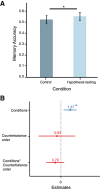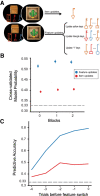Decision uncertainty during hypothesis testing enhances memory accuracy for incidental information
- PMID: 35293323
- PMCID: PMC8973392
- DOI: 10.1101/lm.053458.121
Decision uncertainty during hypothesis testing enhances memory accuracy for incidental information
Abstract
Humans actively seek information to reduce uncertainty, providing insight on how our decisions causally affect the world. While we know that episodic memories can help support future goal-oriented behaviors, little is known about how hypothesis testing during exploration influences episodic memory. To investigate this question, we designed a hypothesis testing paradigm, in which participants figured out rules to unlock treasure chests. Using this paradigm, we characterized how hypothesis testing during exploration influenced memory for the contents of the treasure chests. We found that there was an inverted U-shaped relationship between decision uncertainty and memory, such that memory was best when decision uncertainty was moderate. An exploratory analysis also showed that surprising outcomes lead to lower memory confidence independent of accuracy. These findings support a model in which moderate decision uncertainty during hypothesis testing enhances incidental information encoding.
© 2022 Shen et al.; Published by Cold Spring Harbor Laboratory Press.
Figures







Similar articles
-
Uncertainty alters the balance between incremental learning and episodic memory.Elife. 2022 Dec 2;11:e81679. doi: 10.7554/eLife.81679. Elife. 2022. PMID: 36458809 Free PMC article.
-
Positive reward prediction errors during decision-making strengthen memory encoding.Nat Hum Behav. 2019 Jul;3(7):719-732. doi: 10.1038/s41562-019-0597-3. Epub 2019 May 6. Nat Hum Behav. 2019. PMID: 31061490 Free PMC article.
-
A neural network model of when to retrieve and encode episodic memories.Elife. 2022 Feb 10;11:e74445. doi: 10.7554/eLife.74445. Elife. 2022. PMID: 35142289 Free PMC article.
-
[Memories of the Future - A Narrative Literature Review of Episodic Future Thinking].Neuropsychopharmacol Hung. 2023 Sep;25(3):142-154. Neuropsychopharmacol Hung. 2023. PMID: 37725751 Review. Hungarian.
-
Animal models of source memory.J Exp Anal Behav. 2016 Jan;105(1):56-67. doi: 10.1002/jeab.173. Epub 2015 Nov 26. J Exp Anal Behav. 2016. PMID: 26609644 Review.
Cited by
-
Free recall is shaped by inference and scaffolded by event structure.Commun Psychol. 2025 Apr 26;3(1):71. doi: 10.1038/s44271-025-00243-4. Commun Psychol. 2025. PMID: 40287539 Free PMC article.
References
-
- Bates D, Mächler M, Bolker B, Walker S. 2015. Fitting linear mixed-effects models using lme4. J Stat Softw 67: 1–48. 10.18637/jss.v067.i01 - DOI
-
- Gottlieb J, Lopes M, Oudeyer P-Y. 2016. Motivated cognition: neural and computational mechanisms of curiosity, attention, and intrinsic motivation. In Advances in motivation and achievement (ed. Kim S et al.), vol. 19, pp. 149–172. Emerald Group Publishing Limited, Bradford, West Yorkshire, England.
Publication types
MeSH terms
Grants and funding
LinkOut - more resources
Full Text Sources
